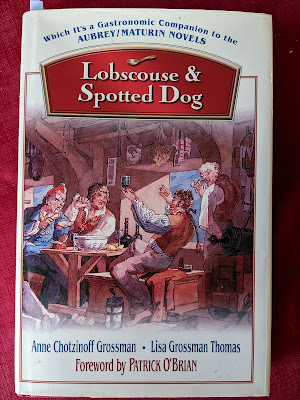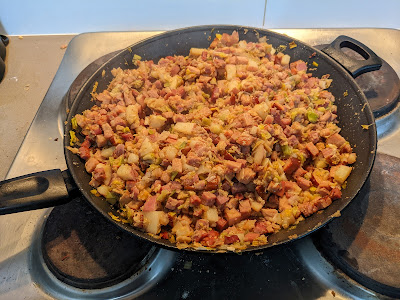I have just finished reading the twenty complete novels of Patrick O'Brian's Aubrey/Maturin series and at one point I dug out my copy of this book:
Anyway, my wife 'suggested' that I might like to actually make use of owning a book like that, and actually cook something out of it. So this weekend I did.
I chose to make the titular dishes - lobscouse, which is a kind of fried mass of meat, leek, onion and potato, and spotted dog, which is a dense suet pudding dotted with currants. These are not dishes that the ordinary seamen would eat; they are taken from a chapter devoted to the menu of a gunroom dinner, so this is officer food.
Lobscouse is based on a mix of both salt beef and salt pork, which is boiled first to tenderise it. It's then chopped up and fried, then added to fried, chopped onion, leek and potato. It's cooked through, and then at the end a stock is added (the water you boil the meat in) as well as some crushed ship's biscuit, the latter thickening it somewhat. A selection of spices are also added for flavour.
And this is the final result of over four hours of cooking and preparation. Enough lobscouse for six generous helpings
I actually used corned beef and smoked ham, which were both pre-cooked, but still boiled them for an hour each to tenderise them. Uncooked salted meat has to be boiled for 2-3 hours!
A serving for one, in one of our delightful bowls from the Tunisian town of Nabeul. The colour difference is simply down to different lighting.
As seen in a previous post, here's the ship's biscuit that's used for thickening. The photo was taken before I pounded them to crumbs (I actually used a food-processor, because I'm lazy like that. Even then I almost burned out the motor. Those things are tough.)
And on to the pudding - a spotted dog suitable for six generous servings (and nine restrained ones). Enough that we'll be eating spotted dog for pudding at least a couple more times this week.
As a suet pudding this should have been steamed for two hours. Again I took a short-cut and simply did it in the microwave. It took just under ten minutes.
An 18th century recipe doesn't include raising agents, which are apparently a thing of the mid-1800s onwards, so the final pudding is much denser than you might expect from a more modern recipe. We served it with custard, which is what the book recommends as well.
And the verdict?
We liked the lobscouse. It's quite salty and contains a lot of meat, but was tasty and substantial. However as nice as it was we didn't feel it was worth the time. But, saying that, the underlying principle of it is sound, and we've worked out quicker versions that will capture its vibe without taking even half the time. My daughter has already earmarked a chunk of the leftover lobscouse to take to work for their lunch one day. The remains will do the three of us for another meal.
Unfortunately I was the only one who liked the spotted dog. It wasn't that the other two thought that it was horrible, but it was quite dense and stodgy, and not to their taste. I will have some more, and the other two might be persuaded, but I'm sad to say that some of it will probably end up feeding the chickens. And they will love it.
Even if you don't cook anything from it, 'Lobscouse and Spotted' dog is a great book. The author's tried all of the recipes and dishes they could find mentioned in the book, from naval staples like these two dishes, to whole roast lamb stuffed with rice and even some of the more hideous options such as cooked rat (although they admitted to not even attempting to consume the rainwater filled with bird guano from 'HMS Surprise' - serves one). A highly recommended book.






Lobscouse looks and sounds very like the Scottish dish Stovies
ReplyDeleteIt possibly is. There's a discussion in the book about its uncertain origins and not everything listed is specifically naval.
DeleteInteresting experiment. You probably know that Lobscouse is the origin of the term ‘Scouser’ for Liverpudlians. Poorer folk would have less/no meat. I think the dish’s origins are in Norway.
ReplyDeleteAs for the pudding, the name forms the basis for much smutty humour here in England.
Chris/Nundanket
As a very small child, perhaps no more than 4 or 5 (??) one of my earliest memories is sitting on my grandads knee while he had his dinner, and stealing spoonful's of his spotted dick/dog pudding.. glorious stuff...
DeleteMy wife and daughter weren't that enamoured of the spotted dog - it was quite heavy. So after a couple of helping with custard over two days I was left to finish the small quantity of leftovers. I found a reference in the book to frying slices of it in butter and, let me tell you, it was amazing!
DeleteHow do you get the traditional weevils into the biscuits?
ReplyDeletePatience.
DeleteAlthough this post *has* attracted the attention of this blog's very own weevil, the Anonymous Coward, who has posted eight abusive comments on it today. All quietly tapped out on the table and squashed, though :)